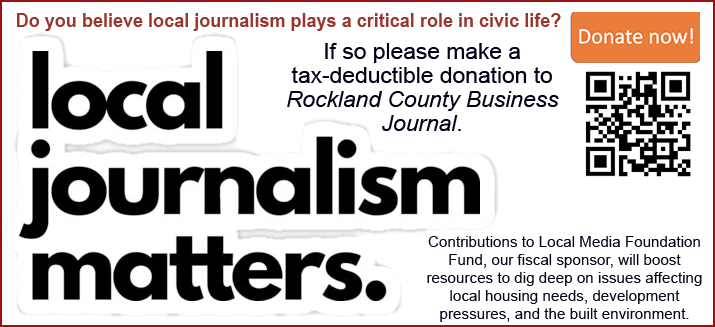|
RCBJ-Audible (Listen For Free)
|
Editor’s Note: A proposal by the Islamic Center of Rockland to construct a 29,000 square foot gymnasium/multi-purpose building with 200 parking spaces on R-160 Zoned Conservation Land on Mountainview Avenue in Valley Cottage is working its way through Clarkstown’s land use boards. The applicant’s experts have represented that the clearing of the forest and construction of the building would not have any significant adverse impact on the environment.
Clarkstown Planning Board Presented With A Proposal On Mountainview Avenue In Valley Cottage That Would Denigrate Habitat For Migrating And Nesting Birds And Local Wildlife
By Christine Toth
Looking out over the Hudson at Memorial Park in Nyack late one night, I watched the lights on the Governor Mario M. Cuomo Bridge fade across the river. It happens quietly, at 11 p.m., when most people have already gone to sleep. But for thousands of birds—thrushes, kinglets, and other songbirds navigating by the stars—it’s the difference that can mean survival.
This spring and fall mark the first full migration seasons that the Thruway Authority has dimmed the bridge lights nightly to protect birds. The change followed outreach from local environmental groups, including Rockland Audubon and the Sierra Club. To its credit, the Authority listened. By April, the bridge was dimming nightly—setting a precedent for bird-friendly lighting on major infrastructure. Each night, the tower and cable lights soften, and the Hudson reclaims its darkness, demonstrating how collaboration can drive real environmental progress.
A few miles away, though, a very different story is unfolding in Valley Cottage. A proposed development at the Islamic Center of Rockland (ICR) would clear six wooded acres—habitat important to migrating birds and suitable for nesting in the same corridor the bridge spans. I live about half a mile from the site on Mountainview Avenue where migration is evident year-round. From my deck, I’ve heard Wood Thrushes sing on summer mornings. In autumn, hummingbirds stop at Jewelweed along their journeys south. In winter, Great Horned Owls call through the cold nights, and in spring, warblers move through the trees—many from as far as Central and South America.
Owls, chickadees, titmice, and other wildlife nest in tree cavities created by woodpeckers. Together they make up the community of life that depends on these remaining woodlots.
These woods also lie within the region that witnessed the return of Bald Eagles to Rockland County after near-extinction in the 1970s. Rockland Audubon’s Christmas Bird Count has documented a steady rise in eagle sightings—one of the clearest signs of recovery in the Hudson Valley. Their comeback remains fragile, dependent on clean water, protected habitat, and careful stewardship.
Across Rockland, the loss of forest understory—an issue rarely discussed—includes the decline of both the shrub layer and wildflower ground cover that many birds and insects rely on for nesting and shelter. Without a healthy understory, the next generation of trees cannot grow, threatening the forest’s long-term viability. Deer overbrowsing is a major cause—nature out of balance in an ecosystem missing its predators. When forests can’t regenerate, the few remaining woodlots become even more important for wildlife and for the well-being of the people who depend on them.
At Clarkstown’s planning board meetings, many residents have spoken from their hearts about the natural life around that site. Yet discussion has focused on zoning and construction details, with little acknowledgment of the forest’s ecological value. The property lies within an R-160 Conservation Zone—land specifically intended to protect sensitive natural areas. Why should the community have to fight so hard to defend land that, on paper, is already recognized by the town and the state for its environmental value? If this project proceeds despite those protections, it risks setting a precedent that undermines Clarkstown’s environmental safeguards. A conservation zone should mean conservation.
What troubles me most is how routine these struggles have become. In the face of climate and biodiversity emergencies, governments should be restoring land to nature and concentrating growth in developed areas. Instead, we are debating how to rezone forests for office space, warehouses, and data centers. At this critical moment in time—when progress should be weighed by how much society can heal—we still measure it by how much we can build.
By contrast, the bridge story shows what happens when communities and agencies work together for the common good. The Cuomo Bridge project reminds us that human infrastructure can adapt to coexist with nature. Even before the lights were dimmed, the Thruway Authority installed a nesting platform for Peregrine Falcons and bird-safe glass at the scenic overlooks. The ICR debate reminds us that once habitat is lost, it cannot easily be restored. Migratory birds connect continents, but their survival depends on local choices—town boards, lighting schedules, contiguous forests, and individual awareness.
Here in Rockland, those choices matter. The dimmed bridge represents what can be achieved when community and government find common ground. The proposed tree clearing near the ICR shows what’s at stake when we lose sight of our environment. The birds flying over the Hudson don’t differentiate between artificial light and lost forest—they just need a safe journey and a place to rest.
And as nature might say, the simplest way to say this is:
Bring back the forest.
Take back the night.
Christine Toth is the Conservation Chair of the Rockland Audubon Society, where she leads initiatives focused on bird-friendly lighting, collision prevention, and habitat restoration.
The success on the bridge was not one voice but many—Sierra Club Atlantic Chapter, Rockland and Hudson River Audubon Societies, Riverkeeper, Scenic Hudson, Sustainable Hudson Valley, Friends of Rockland Lake & Hook Mountain, Rockland Astronomy Club, and Palisades Parks Conservancy—each helping to make lasting change along the Hudson.












